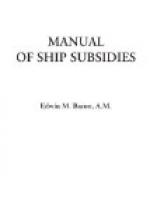In 1910 (May) a new subsidy bill was enacted providing for the continuance of the arrangement under the measure of 1900, with a few immaterial modifications.[DT] Early in 1911 the Government was reported to have in readiness ten bills looking to the support of domestic shipping and shipbuilding. Eight of these had relation to the increase of subsidy on the Italian mail and cargo service of the Mediterranean. Other routes subsidized included lines to Central America, Chile, Canada. Domestic shipbuilding was to be aided to the extent of twelve hundred and forty thousand dollars.[DU]
Italy’s mail subvention system dates from 1877, when the Italian steamship companies by a convention (July 15) consolidated with the Government.[DV] All the lines receiving the mail subsidy came to be owned by a single powerful corporation, the Italian General Navigation Company. While the rates paid per mile are not so high as those paid by several other countries, the requirements as to size of vessels, speed, and amount of service to be rendered, are less exacting. Accordingly these subventions are in fact, as Professor Meeker recognizes them, “partly in the nature of concealed bounties.” In 1879 the Government spent in these subventions a total equalling $1,593,214. By 1889 the total had only slightly increased, the amount that year being $1,849,392. In 1908 the total was $2,328,917. The mail steamships are required to carry government civil and military employees at half price.
Previous to 1896 the Italian General Navigation Company owned more than half of the Italian steam tonnage, and most of the large steamships.[DW] After 1896 the sail tonnage steadily increased. In 1905 it was recorded that “the Italian flag now flies over some of the best modern transatlantic liners in the port of New York; the Mediterranean is full of Italian ships; and the Lloyd Italiano has five new ten-thousand-ton steamers nearly ready for service in South America."[DX] Between 1890 and 1910 the Italian gross tonnage increased from 809,598 tons to 1,320,653 tons.[DY]
FOOTNOTES:
[Footnote DP: Meeker.]
[Footnote DQ: Bismarck’s Memorial to the German Reichstag, April, 1881.]
[Footnote DR: U.S. Con. Rept., Jan., 1890, no. 112, pp. 61-62. Also Meeker.]
[Footnote DS: Meeker.]
[Footnote DT: U.S. Consul J. K. Wood, Venice, in Daily Con. Repts., no. 30, Aug 9, 1910.]
[Footnote DU: U.S. Consul T. St. J. Gaffney, Dresden, Germany, in Daily Con. Repts., no. 83, April 10, 1911.]
[Footnote DV: Meeker.]
[Footnote DW: Meeker.]
[Footnote DX: U.S. Senate Rept., no. 10, 59th Cong., 1st sess.]
[Footnote DY: Lloyd’s Register, 1910-11.]
CHAPTER VIII
SPAIN—PORTUGAL
Spain instituted a ship-construction bounty system in 1880, when her merchant marine was languishing, and in 1886 a comprehensive system of mail subventions, contracting for the whole ocean service with a single steamship company, La Compania Transatlantica Espanola.




